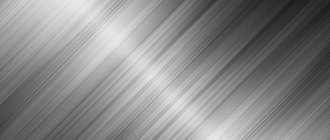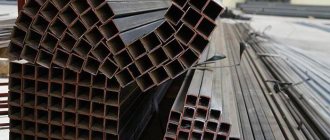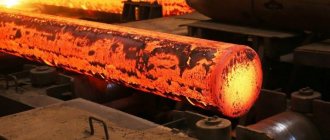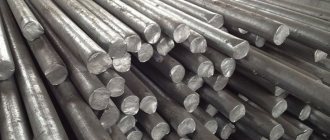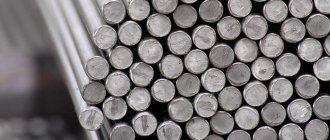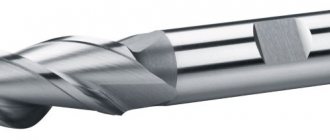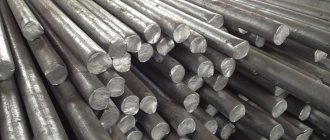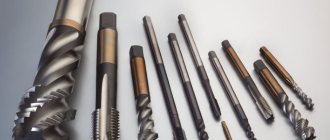Carbon steels
a} Carbon steels of ordinary quality (GOST 380-88) Carbon steels of ordinary quality contain up to 0.07% phosphorus, 0.06% sulfur, 0.06...0.49% carbon and in the equilibrium state have a ferrite-pearlite structure. The letters St in the brand mean “steel of ordinary quality”, the numbers are the conditional number of the brand depending on the standardized indicators (mechanical properties values). The higher the nominal number of steel, the higher the carbon and pearlite content in it and the higher its strength and lower ductility. Carbon steels of ordinary quality are produced in the following grades: StO, St1, St2, StZ, St4, St5, Stb. The standard also provides for steel with a high (0.8...1.1%) manganese content: StZGps, StZGsp and St5Gps. The most common steel StZsp has s = 380...490 MPa, s0.2 = 210...250 MPa and d = 25..22%, and St5sp - s = 500...600 MPa, s0.2 = 240...280 MPa and d = 20...17%. The greater the thickness of the rolled product, the lower the values of the given characteristics. According to the terms of delivery, ordinary quality steels are classified into three groups, the letter designation of which (except A) is indicated at the beginning of the grade:
- • A - supplied according to mechanical properties (St0, St1, St2, StZ, St4, StZ, Stb) for the manufacture of products that are not subject to hot processing;
- • B - supplied by chemical composition (BSt0, BSt1, ..., BStb) for the manufacture of products subjected to hot processing;
- • B - supplied according to mechanical properties and chemical composition (VSt1^ VSt2, ..., VSt5) for the manufacture of welded structures.
Additional indices indicate the degree of deoxidation and the nature of steel hardening (for example, StZkp, St5ps, St6sp). In group A, in the absence of the designations sp, ps, kp, it means calm steel.
In order to harmonize the accepted domestic designation of brands with the international one, GOST 380-94 shows their comparison (Table 1).
Table 1 Comparison of steel grades of type Cm and Fe according to international standards ISO 630-80 and ISO 1052-82
Steel grades
| St | Fe | St | Fe |
| One hundred | Fe310-0 | St4kp | Fe430-A |
| St1kp | St4ps | Fe430-B | |
| St1ps | St4sp | Fe430-C | |
| St1sp | — | — | Fe430-D |
| St2kp | St5ps | Fe510-B, Fe490 | |
| St2ps | St5Gps | Fe510-B, Fe490 | |
| St2sp | Sg5sp | Fe510-C, Fe490 | |
| StZkp | Fe360-A | ||
| StZps | Fe360-B | St6ps | Fe590 |
| StZGps | Fe360-B | Stbsp | Fe590 |
| StZsp | Fe360-C | Fe690 | |
| StZGsp | Fe360-C | — | |
| Fe360-D |
Carbon structural steels of ordinary quality are intended for the manufacture of:
- hot rolled steel;
- cold rolled thin sheets;
- ingots, blooms, slabs;
- pipes;
- forgings and stampings;
- hardware, etc.
- Rolling production is the production of various products and semi-finished products from metals and alloys by rolling, as well as their additional processing in order to improve quality. In industrial countries, more than 80° of the smelted steel is rolled. The main types of rolled products: long and sheet products, metal profiles and tin.
- Pipe production is also carried out for ceramics, asbestos cement, brick, reinforced concrete, wood, glass, rubber, plastics and other materials.
Products made from carbon structural steels of ordinary quality are widely used in construction for welded, riveted and bolted structures, as well as for roofing work. Medium-carbon steels (St5, St5G), which have greater strength than low-carbon steels, are intended for rails, railway wheels, as well as shafts, pulleys, gears and other parts of lifting machines.
The mechanical properties of carbon structural steel of ordinary quality can be significantly increased, and the cold brittleness threshold can be lowered by quenching in water after rolling heating.
b) high-quality carbon steels
- High-quality carbon structural steels (GOST 1050-74) contain no more than 0.35% phosphorus, no more than 0.04% sulfur, 0.05...0.6% carbon. These steels are characterized by high ductility and weldability. They can be used without or after hardening heat treatment.
- High-quality carbon steels are marked with numbers 08, 10, 15, 20, …. 85. Two-digit numbers in the stamp indicate the carbon content in hundredths of a percent. Additional indices can indicate the degree of deoxidation and the nature of steel solidification in the mold (for example, steel 08kp).
- Low-carbon (less than 0.25% C) high-quality structural steels have low strength ((Te = 330...460 MPa, Sto.2 = 200...280 MPa) and high ductility (5 = 33...23%). Steels 05kp, 08kp, 08 , 10 are used for the manufacture of parts of complex configurations using the cold stamping method. Bolts, nuts, screws, pins, rolls, axles, hooks, studs and other parts for non-critical purposes are made from steels 15kp, 15, 20. If parts from these steels are used in wear conditions surfaces, they are subjected to surface hardening by carburization or nitrocarburization.
- Medium carbon (0.3..0.5% C) steels 30, 35, ..., 55 are used after normalization, improvement and surface hardening. After improvement, steel 40, 45, 50 have the following mechanical properties: s = 600...700 MPa, s0.2= 400...600 MPa, y= 50...40% and KCU = 0.4...0.5 MJ/m2. The hardenability of these steels is low. Steels 30, 35, 40, 45 are used for the manufacture of parts that require a combination of high strength and toughness of the core (axles, shafts, screws, washers, bushings, crankshafts, etc.).
- Steels 60, 65, ..., 85 with a high content (0.6 ... 0.85%) of carbon have increased strength, wear resistance and elastic properties. They are used after quenching and tempering, normalizing and tempering, and surface hardening. Steels 65, 70, 75, 80, 85 are used to make parts that operate under conditions of friction and vibration loads: rolling rolls (steel 60), crane wheels (steel 75), clutch discs and compressor inlet valves (steel 85), as well as springs and springs (GOST 14959-79).
Designation and interpretation of steel grades according to GOST
In Russia and the CIS, an alphanumeric system has been adopted; numbers indicate the content of steel elements, and letters indicate the name of the elements.
Letter designations are also used to indicate the method of steel deoxidation; KP - boiling steel, PS - semi-quiet steel, SP - calm steel.
There are certain designation features for different groups of construction, structural, stainless steel, tool steel, etc.
The designations common to all are the letter designations of alloying elements: H - nickel, X - chromium, K - cobalt, M - molybdenum, B - tungsten, T - titanium, D - copper, G - manganese, C - silicon.
Structural steels of ordinary quality, unalloyed
(GOST 380-94) are designated by the letters ST., for example ST. 3. The number after the letters conventionally indicates the percentage of carbon in the steel.
Structural unalloyed quality steels
(GOST 1050-88) are designated by a two-digit number indicating the average carbon content in steel (for example, ST. 10).
Quality steels
For the production of boilers and high-pressure vessels, (GOST 5520-79), they are designated as structural non-alloy steels, but with the addition of the letter K (for example, 20K).
Structural alloy steels
(GOST 4543-71), designated by letters and numbers. The numbers after each letter indicate the approximate content of the corresponding element, however, if the content of the alloying element is less than 1.5%, the number after the corresponding letter is not placed. Qualitative additional indicators, a reduced content of impurities such as sulfur and phosphate, are designated by the letter A or Ш, at the end of the designation, for example (12 X NZA, 18ХГ-Ш), etc.
Cast structural steels
(GOST 977-88), are designated as high-quality and alloyed, but at the end of the name they put the letter L.
Construction steel
(GOST 27772-88), denoted by the letter C and numbers corresponding to the minimum yield strength of steel. Additionally, the following designations are used: T - heat-strengthened rolled steel, K - increased corrosion resistance (for example, C 345 T, C 390 K, etc.). Similarly, the letter D denotes high copper content.
Bearing steels
(GOST 801-78), are designated in the same way as alloyed ones, but with the letter Ш at the end of the name. It should be noted that for electroslag remelted steels, the letter Ш is indicated by a dash (for example, ШХ 15, ШХ4-Ш).
Unalloyed tool steels
(GOST 1435-90), are divided into high-quality, denoted by the letter U and a number indicating the average carbon content (for example, U7, U8, U10) and high-quality, denoted by an additional letter A at the end of the name (for example, U8A) or an additional letter G, indicating an additional increase in manganese content (for example, U8GA).
Alloyed tool steels (GOST 5950-73) are designated in the same way as structural alloyed steels (for example, 4Х2В5МФ, etc.).
High speed steel
In their designation they have the letter P (the designation of steel begins with this), followed by a number indicating the average tungsten content, and then letters and numbers determining the mass content of the elements. They do not indicate the chromium content, since it is consistently about 4% in all high-speed steels, and carbon, since the latter is always proportional to the vanadium content. It should be noted that if the vanadium content exceeds 2.5%, the letter F and number are indicated (for example, steel R6M5 and R6 M5F3).
Standard stainless steel
(GOST 5632-72), are marked with letters and numbers according to the principle adopted for structural alloy steels (for example, 08Х18Н10Т or 16Х18Н12С4ТУЛ).
Stainless steel, non-standard
Experimental batches are designated by letters - indices of the manufacturer's plant and serial numbers. EI, EP, EK - for steels produced in , ChS - for steels produced in Chelyabinsk, DI - for steels produced in .
To indicate the finishing smelting method, the names of a number of steels are supplemented with letters (for example, 13Х18Н10-VI), which means vacuum induction smelting.
Tool carbon steels
- In carbon tool steels (GOST 1435-74), the letter U in the brand designation means “carbon steel”, and the number indicates the carbon content in tenths of a percent.
- Carbon tool steels can be produced as high-quality (sulfur content does not exceed 0.03%, phosphorus - 0.035%) and high-quality (with sulfur content not more than 0.02% and phosphorus - 0.03). The letter A is placed at the end of the grade of high-quality carbon tool steels.
- Steels U7 (hypoeutectoid ferrite-pearlite) and U8, U8A (eutectoid) are the most ductile of the carbon tool steels. They are used to produce hammers, chisels, chisels, and chisels.
- Cutters, drills, taps, milling cutters, tiles and other measuring and cutting tools for cutting soft materials are made from steels U 10, U11, U11A. Steels U12, U13, U13A are used for the manufacture of tools that operate without shock loads (files, rasps, razors).
Alloy steels
When marking alloy steel, the letter designations of alloying elements are used (Table 2). These letters combined with numbers form the steel grade.
In the brand, the content of the alloying element, if it exceeds 1...1.5%, is indicated by a number (mass fraction in whole percent) following the corresponding letter. If there is no number behind the letter, then the content of this element is about 1%. An exception is made for some elements (V, Ti, Mo, Nb, Zr , B, N, etc.), the presence of which in steels, even in thousandths of a percent, has a significant effect on the properties of steel (microalloying).
Table 2. Symbols of alloying elements in metals and alloys
| Element | Symbol | Designation of elements in grades of metals and alloys | Element | Symbol | Designation of elements in grades of metals and alloys | ||
| black | colored | black | colored | ||||
| Nitrogen | N | A | — | Neodymium | Nd | — | Nm |
| Aluminum | A1 | YU | A | Nickel | Ni | — | N |
| Barium | Va | — | Br | Niobium | Nb | B | Np |
| Beryllium | Be | L | Tin | Sn | — | ABOUT | |
| Bor | IN | R | — | Osmium | Os | — | OS |
| Vanadia | V | f | To you | Palladium | Pd | — | front |
| bismuth | Bi | In and | In and | Platinum | Pt | — | Pl |
| Tungsten | W | IN | — | Praseodymium | Pr | — | Etc |
| Gadolinium | Gd | — | Gn | Rhenium | Re | — | Re |
| Gallium | Ga | Gi | Gi | Rhodium | Rh | — | Rg |
| Hafnia | Hf | — | Gf | Mercury | Hg | — | R |
| Germanium | Ge | — | G | Ruthenium | Ru | — | Pv |
| Holmium | But | — | GOM | Samarium | Sm | — | Myself |
| Dysprosium | Dv | — | DIM | Lead | Pb | — | WITH |
| Europium | Eu | — | Ev | Selenium | Se | TO | ST |
| Iron | Fe | — | AND | Silver | Ag | — | Wed |
| Gold | Au | — | Evil | Scandium | Sc | — | From km |
| Indium | In | — | In | Antimony | Sb | — | Cv |
| Iridium | Ir | — | AND | Thallium | Tl | — | Tl |
| Ytterbium | Yb | — | ITN | Tantalum | Ta | — | TT |
| Yttrium | Y | — | THEM | Tellurium | Those | — | T |
| Cadmium | Cd | CD | CD | Terbium | Tb | — | Volume |
| Cobalt | Co | TO | TO | Titanium | Ti | T | TPD |
| Silicon | Si | WITH | Kr(K) | T\'liy | Tm | — | TUM |
| Lanthanum | La | — | La | Carbon | WITH | U | — |
| Lithium | Li | — | Le | Phosphorus | P | P | F |
| Lutetium | Lu | — | Leung | Chromium | Cr | X | X(Xp) |
| Magnesium | Mg | Sh | Mg | Cerium | Ce | — | Xie |
| Manganese | Mn | G | Mts(Mr) | Zinc | Zn | — | C |
| Copper | Cu | D | M | Zirconium | Zr | C | TsEV |
| Molybdenum | Mo | M | — | Erbium | Er | — | Erm |
If there is no number at the beginning of the brand, then the amount of carbon is 1% or higher. For structural steels, two numbers in front of the grade indicate the average carbon content in hundredths of a percent. For tool steels, one number at the beginning of the grade means the average carbon content in tenths of a percent. The bulk of alloy steels are smelted of high quality. The difference in the designation of high-quality, high-quality and especially high-quality steels is that at the end of the grade of high-quality steels the letter A is assigned, and for especially high-quality steels - the letter Ш. For steels used in the form of casting (in casting), the letter L is assigned at the end of the grade. high-quality steels there are deviations from these rules. Thus, in grades of tool alloy steels, as well as steels and alloys with special physical properties, the letter A is not indicated, since all of them are always high-quality (or especially high-quality). Some groups of special-purpose steels contain additional designations: grades of ball bearing steels begin with the letter Ш, high-speed steels with the letter P, electrical grades with the letter E, magnetically hard steels with the letter E, machine guns with the letter A. More details on the marking of these steels will be provided reported in the relevant sections.
Marking of steels (GOST)
In this post I will give the basic principles of our domestic steel marking.
Designation of unalloyed structural steels of ordinary quality according to the GOST marking system
Unalloyed structural steels of ordinary quality in accordance with GOST 380 are designated as follows: “St_number_letters”.
For example: St3sp, St5kp, St0, etc.
- St - letters indicating that the steel belongs to the group of ordinary quality steels.
- The letters “St” are followed by a conventional number from 0 to 6, indicating the percentage of carbon content, but not proportional to it. For example, in St3sp the C content is from 0.14 to 0.22; in St5sp it is from 0.28 to 0.37.
- In the designation of steels with a high Mn content, the letter “G” is added after the number. For example, St3Gsp, St5Gps.
- Behind the numbers at the end of the name of the steel there are letters that determine the degree of its deoxidation: “kp” - boiling, “ps” - semi-calm, “sp” - calm).
Designation of unalloyed structural quality steels according to the GOST marking system
For example: 08kp, 10ps, 15, 18kp, 20, 15K, 18K, etc.
- High-quality structural steels in accordance with GOST 1050 are designated by a two-digit number indicating the approximate carbon content in the steel, in hundredths of a percent (in whole numbers).
- The letters “kp” or “ps” are added to the designation of steels with a C content of less than 0.2 that have not been subjected to complete deoxidation (for boiling and semi-quiet, respectively). For mild steels, letters are not added at the end of their names
- High-quality steels with improved properties, used for the production of boilers and high-pressure vessels, are designated according to GOST 5520 with the addition of the letter K at the end of the name of the steel
Designation of steels according to the GOST marking system for alloy steel grades
Alloyed structural steels of ordinary quality in accordance with GOST 4543 are designated as follows: “Two numbers_letters”.
For example: 20KhGNM, 15KhGN2TA
- The first two digits indicate the average mass fraction of carbon in hundredths of a percent.
- The following are letters that indicate the main alloying elements: P - boron, Yu - aluminum, C - silicon, T - titanium, F - vanadium, X - chromium, G - manganese, N - nickel, M - molybdenum, V - tungsten , A - nitrogen.
- The numbers after these letters indicate the approximate mass fraction of the alloying element in whole units. The absence of a number means that the brand contains up to 1.5% of the alloying element.
- The letter A at the end of the brand name means “high-quality steel.”
- “Particularly high-quality” steel is designated by the letter Ш separated by a dash at the end of the brand name. For example, high-quality - 30ХГС; high quality - 30ХГСА; especially high quality - 30ХГС-Ш, 30ХГСА-Ш.
In addition to the designations of alloying elements given in GOST 4543, there are also the following:
D - copper, B - niobium, E - selenium, P - phosphorus, K - cobalt
I am soon planning to publish an article about the principles of marking steel according to European standards, so I recommend subscribing to blog updates.
If you find an error, please select a piece of text and press Ctrl+Enter.

